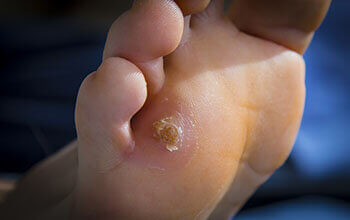Corns Treatment in Detroit, MI
 If you happen to wear tight fitting shoes or tend to stand for the majority of your day, it’s likely that you may develop a foot condition known as a corn. When frequent friction or pressure is put on the foot, a small, hardened lump may form in that area. A corn may have a yellow hue and can typically be found on the side of the toes, as well as on the bottom of the feet. Though they are generally harmless, corns can often bring many patients discomfort.
If you happen to wear tight fitting shoes or tend to stand for the majority of your day, it’s likely that you may develop a foot condition known as a corn. When frequent friction or pressure is put on the foot, a small, hardened lump may form in that area. A corn may have a yellow hue and can typically be found on the side of the toes, as well as on the bottom of the feet. Though they are generally harmless, corns can often bring many patients discomfort.
Corns are thickened areas on the skin’s surface, to the point of being irritating and sometimes painful. Commonly found on the feet, corns are circular or cone-shaped and develop where there are areas of pressure or friction, such as on the little toe when it rubs up against shoes or on the ball of your foot.
Corns are often confused with a callus, but there is a difference between them. Corns can be raised bumps that are painful to the touch. They consist of a rough, thick area of skin that may be dry or waxy. Corns tend to be surrounded by skin that is inflamed, and are usually much smaller than calluses.
Foot Corns Prevention
To help prevent yourself from developing a corn, it’s important to wear shoes that give your toes enough room to comfortably move around. Some patients may also find it useful to soak the feet with warm water, pat them dry, and apply a moisturizer. After practicing these steps over a period of time, the corn will most likely soften. Your podiatrist may choose to file the corn down.
The best treatment for a corn varies from person to person and is best determined by a podiatrist. Certain topical over-the-counter products may be suggested, or a more serious treatment may be prescribed. Diabetics should consult with a podiatrist immediately if they have developed a corn, as small wounds such as corns can develop into more serious conditions.
Orthotic inserts, which are fitted by a podiatrist, may also help with treating corns. Inserts fit right into the shoes and adjust the way the feet fit into the shoes, thus fixing the way one walks. Proper-fitting orthotics can help reduce friction, which can in turn help reduce corn formation and exacerbation.
To help prevent yourself from developing a corn, it’s important to wear shoes that give your toes enough room to comfortably move around. Some patients may also find it useful to soak the feet with warm water, pat them dry, and apply a moisturizer. After practicing these steps over a period of time, the corn will most likely soften. Your podiatrist may choose to file the corn down.
Surgery is rarely used to treat corns, but does occur on occasion. Corn surgery actually deals with the underlying issue that causes corns. During surgery, the bone is shaved and any abnormalities are corrected, thus reducing the amount of friction that occurs during walking.
For more information and professional removal of your corn, we recommend you consult with a podiatrist for an advised treatment plan.
